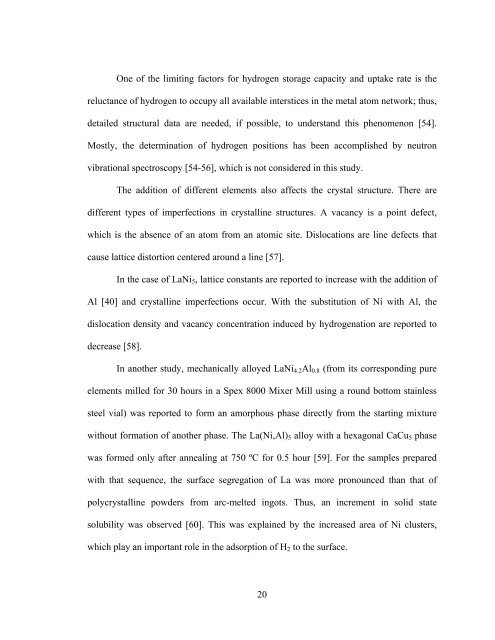Create successful ePaper yourself
Turn your PDF publications into a flip-book with our unique Google optimized e-Paper software.
One of the limiting factors for hydrogen storage capacity and uptake rate is the<br />
reluctance of hydrogen to occupy all available interstices in the metal atom network; thus,<br />
detailed structural data are needed, if possible, to understand this phenomenon [54].<br />
Mostly, the determination of hydrogen positions has been accomplished by neutron<br />
vibrational spectroscopy [54-56], which is not considered in this study.<br />
The addition of different elements also affects the crystal structure. There are<br />
different types of imperfections in crystalline structures. A vacancy is a point defect,<br />
which is the absence of an atom from an atomic site. Dislocations are line defects that<br />
cause lattice distortion centered around a line [57].<br />
In the case of LaNi 5 , lattice constants are reported to increase with the addition of<br />
Al [40] and crystalline imperfections occur. With the substitution of Ni with Al, the<br />
dislocation density and vacancy concentration induced by hydrogenation are reported to<br />
decrease [58].<br />
In another study, mechanically alloyed LaNi 4.2 Al 0.8 (from its corresponding pure<br />
elements milled for 30 hours in a Spex 8000 Mixer Mill using a round bottom stainless<br />
steel vial) was reported to form an amorphous phase directly from the starting mixture<br />
without formation of another phase. The La(Ni,Al) 5 alloy with a hexagonal CaCu 5 phase<br />
was formed only after annealing at 750 ºC for 0.5 hour [59]. For the samples prepared<br />
with that sequence, the surface segregation of La was more pronounced than that of<br />
polycrystalline powders from arc-melted ingots. Thus, an increment in solid state<br />
solubility was observed [60]. This was explained by the increased area of Ni clusters,<br />
which play an important role in the adsorption of H 2 to the surface.<br />
20



